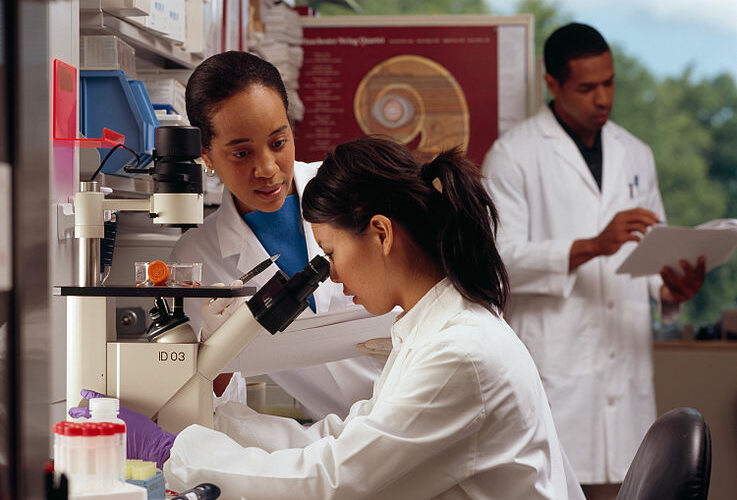Down-sizing to upgrade: How nanomedicine might, eventually, revolutionise cancer treatment

Nanocarriers, often referred to as ‘nanoballoons’ or ‘nanobubbles’, have long been considered the next big thing in cancer treatment. Yet they haven’t delivered the revolutionising results scientists and doctors have hoped for – perhaps until now. A number of recent studies show exciting new insights about how nanocarriers can be used to selectively carry and deliver cancer drugs to the location of interest, overcoming a range of problems which have previously been connected to the method.
This “nano” thing – explained
Nano simply (or not so simply) means something which takes place on the nanoscale, meaning one billionth of a metre .The nanometre scale is usually taken to be between 1 nm to 100 nm, one nm being 1×10-9 m. This scale is useful for describing atoms and molecules, thus also engineering at this small scale. However, nano isn’t just tiny things. Nanoparticles can exhibit quite interesting and surprising properties, often of quantum character, making them a whole different game to work with compared to their bulk counterparts.
Most of the strange properties of nanoparticles come from their surface area, a seemingly dull concept to those not inaugurated. Physicists and chemists will know that surface areas are, in fact, the bees’ knees; it’s where reactions take place. Intuitively, this makes sense – incoming compounds which a material might interact with can only start with surface atoms, as they ‘cover’ bulk atoms. In larger, non-nano bulk materials, the number of atoms on the surface of the material is pretty insignificant to the number of atoms in the bulk (as in, the rest of the chunk of stuff you have). With nanoparticles, the tables have turned; the percentage of atoms on the surface is now significant enough to make interesting things happen. This means that at the nanoscale, your material has size-dependent properties – how it behaves is not just dependent on what your material is but how big it is! Odd nano properties include optical quantum effects (for example strange changes of colour – gold nanoparticles are red or black) and magnetic effects.
Open Sesame and nano-plumbing
In terms of cancer treatment, the main focus for many researchers has been nanocarriers – tiny capsules which cargo drugs. These would work by travelling through the bloodstream to the area of interest, carrying the drug inside of them, and releasing them where they are needed. The idea is that hard-to-access areas would become accessible to treatment, that the drugs would not interfere or harm the healthy surroundings and that the treatments wouldn’t become diluted or less effective on the way. So far so good – but a fully grown concept does not necessarily equal a fully grown solution.
A fundamental problem is: how do you get a nanocarrier to open and release medicine not before, not after, but exactly at the time and position wanted? Preferably it is non-invasive, easy and cheap. It has been known for some time that some nanocarriers when they are heated to a specific phase transition-inducing temperature (around 42 degree Celsius) open to release their cargo, and this method is now in human trials 1. However, heating tissue, even if it’s just a few degrees above body temperature, may cause damage to healthy tissue and significantly impact drug delivery and effect. Likewise, if what you are transporting isn’t easily contained – like a radioactive isotope dying to shoot out alpha-particles – how do you prevent leakage? The cleverness of carrying it only to the point of interest would obviously be compromised if it resulted in radioactive pollution of the rest of the body.
The question thus remains of how we can overcome these challenges and make them a better alternative to existing options.
In the soft glow of Near Infra-Red lasers
Nanocarried chemotherapeutic drugs have received a great big push forwards in the form of a new study from the University of Buffalo, New York, published in Nature Communications this April 2. The researchers slightly altered the structure of some porphyrin-phospholipid (PoP) liposomes to make self-assembling, cargo-carrying nanocarriers. They then turned towards a bigger challenge – making the PoPs pop open (I apologise, this obviously wasn’t my pun to begin with). They found that by irradiating it with a near infra-red (NIR) laser, after an optimal portion of their altered molecule, the nanocarrier opened and released its cargo steadily over three minutes.
Interestingly, they found that the tissue didn’t show any significant increase in temperature (<0.5 degrees Celsius). Furthermore, carriers retained their cargo even at 90 degrees Celsius, strongly indicating that phase-inducting heating effects weren’t responsible for the cargo release. In fact, the exact mechanism of the light-induced release is unclear: “Why PoP-liposomes, or nanoballoons, open in response to an otherwise harmless red laser is still a bit of a mystery to us, but we have definitely unearthed a new and unique phenomenon,” says Jonathan Lovell, assistant professor of biomedical engineering at University of Buffalo 3. Much more research is obviously needed before this reaches actual cancer therapies but Lowell says human trials could start already in five years.
Insulating amino acids
In the field of radiotherapy, nanoparticle research, too, is gaining ground. A recent study from Kansas State University managed to create a nanocarrier which could safely transport a radioactive isotope 4. A very effective form of radiotherapy is alpha particle transmitting radioisotopes, and these are potentially quite harmful.
John M. Tomich, professor of biochemistry and molecular biophysics at the university explains: “The problem with current alpha-particle radiation therapies used to treat cancer is that they lead to the release of nontargeted radioactive daughter ions into the body. […] Once freed, the daughter isotopes can end up in places you don’t want them, like bone marrow, which can then lead to leukemia and new challenges.” 5 The team made nanocarriers from other small molecules – amino acids – instead of lipids, which gave the nanocarriers certain unique features allowing them to transport radioactive isotopes. They found that as the isotopes decay, the alphaparticles simply bounce off the nanocapsule wall, effectively containing them inside carrier. If harmful radioactive drugs can be kept safely from the healthy tissue, this would naturally have huge beneficial implications in cancer therapy – however, there is still a lot of work to be done.
Cancer nano revolution – or what?
The recent progress is exciting, yet science is often a slow process built on hard work and good intuition. The nanoscale offers a range of useful features which researchers can exploit, but they also come with less desirable properties which we must learn to control. A study recently published in Nature Communications 6 showed that one of these nano challenges is that their size is difficult to control; as the way they work is much dependent on their size, this creates problems.
“The problem lies in assuming that once [the nanocarriers are] (red.) produced, they don’t change. […] Simple agitation can completely alter the distribution profile of the nanocarrier-drug complex in the body,” explains Thomas H. Epps, III, of University of Delaware, a lead author of the paper. The researchers explain how shaking the nanocarrier can make it grow from 75 to 150nm. This might not seem like too big of a deal but it can actually make the difference between the capsule (containing the rather toxic chemotherapeutic drug) travelling to the target area like you want it to, or accumulating in the liver or spleen, potentially causing damage.
Overall, the nanorevolution hasn’t quite arrived yet. Steps are being taken, but methods must be perfected, combined and trialled. There is also uncertainty as to what consequences nanoparticles, both in medicine and technoloogy, might have. This knowledge will accumulate,with more research, and we will hopefully be able to properly regulate and exploit the approach. Revolutions are hard work, but in terms of future cancer therapies, it looks as though size does matter.
Down-sizing to upgrade: How nanomedicine might, eventually, revolutionise cancer treatment by Ida Emilie Steinmark was specialist edited by Michaela Mrschtik and copy edited by Sophie Kortenbruck
References
- Manzoor, A.A., et al.Overcoming Limitations in Nanoparticle Drug-Delivery: Triggered, Intravascular Release to Improve Drug Penetration into Tumors. Cancer Research. 2012; 72(21): 5566-5575.
- Carter, K.A., et al. Phorphyin-phospholipid liposomes permeabilized by near-infrared light. Nature Communications. 2014.
- Press release
- Sukthankar, P., et al. Branched amphiphilic peptide capsules: Cellular uptake and retention of encapsulated solutes. Biochimica et Biophysica Acta (BBA) – Biomembranes. In press.
- Press release
- Kelley, E.G., et al. Size evolution of highly amphiphilic macromolecular solution assemblies via distinct bimodal pathway. Nature Communications. 2014; 5: 3599.










